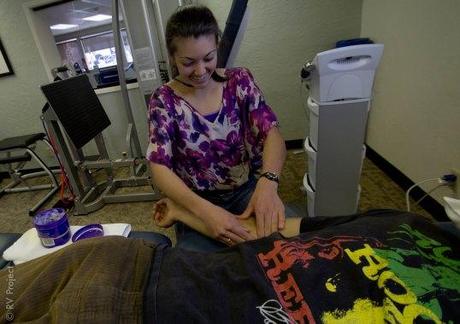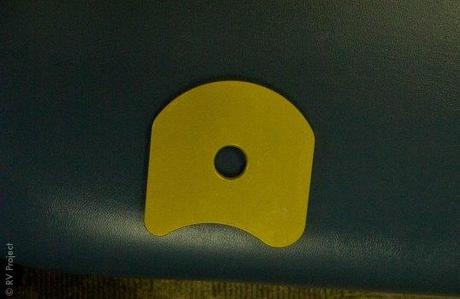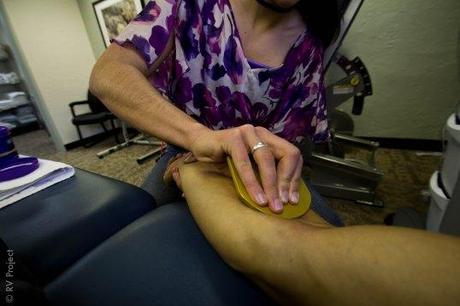Elbow tendinitis. Like I said, it totally wasn’t worth it. Sitting around Bishop and not climbing on some of my favorite boulders in the country is lame, but if there’s a silver lining to this whole elbow thing, it’s the fact that I’ve learned quite a bit about what to do if the demon gets you. The last post (linked above) admonishes those who might be tempted to ignore the pain and/or live with it. This one sums up what I’ve learned so far.

Jen does some massage on the affected forearm.
I should mention that I got in this mess by ignoring about 2 years’ worth of elbow inflammation. If you are just getting started with your “itis,” you’re in luck. A little bit of care will see you through. But if you’re a chronic patient like myself, you might need to throw the whole kit at the problem.
Strength gains happen much, much faster in muscle than in connective tissue, so idea behind most of the following advice is to isolate tendons, relax muscles when they aren’t being used, and increasing vascularity in the joints.
As a disclaimer, I’m NOT a doctor and you should probably seek real medical treatment. The purpose of this article is to show you what happens when your injuries get the best of you, and what might be done about it. Also, if anyone reading this has any expertise, please leave a comment.
If you’re getting the first signs of medial epicondylitis
You’ll probably want to read this article by Dr. Julian Saunders. It’s the best one I’ve seen on the topic, and he also injects Aussie wit into the prose. (clicking the link will download a PDF) (Thanks Michal!)
The biggest single thing is rest. I can’t stress this enough. Listen to your body. It needs rest. Avoid things that hurt it. Mix in some days of easy sport climbing or something; don’t just boulder hard all the time. REST!
I would emphasize stretching everything above and below the elbow joint. Triceps, biceps, and all sides of the forearm. The theory here is that tense muscles lead to knots and trigger points, and they just sort of constantly pull and tug at things. After a while, this pisses off your connective tissues. Also pay attention to the Brachioradialis stretch in the above-linked article. If you can do your best to relax, or “neutralize” everything above and below the affected joint, you’ll be helping yourself a lot.
Another great way to neutralize your arms is with massage. My friend Mike Papciak is a very skilled bodyworker, helping to get people such as Ethan Pringle back on track. He strongly recommends using a lacrosse ball, and pinning it between your arm and a wall, then just leaning into it with body weight to really dig into the pressure points. Put the ball behind your back to target the flexors. Or get your guy/gal gym crush to help iron out your sexy beefcake arms. Explain that it’s for your health, and all should be fine.
It should go without saying, but since climbing is all pulling, it will lead to muscle imbalance if you do not incorporate antagonistic muscle work. Pushups. Shoulder stabilization. And for our purposes, forearm extensors. For this, I’d recommend the rice bucket, which you can make yourself for $10 or so. Fill a 5-gallon bucket halfway to the top with some rice, and then do this.
If it’s real bad, physical therapy might be in your future
I went to PT twice per week, and did all the stretching and exercises on my own time. While in the office, they first used ultrasound. Dr. J says this will do nothing, but heck, it can’t hurt. Then my therapist, Jen, would use a stainless steel tool and some lotion to scrape up and down my arm near my elbow. It would make a grating sound and hurt slightly. The theory here is to break up the scar tissue that we think is making the crunching noise when I flex my elbow, and also to create micro-trauma to the tendons, which the body then addresses by laying down more collagen.

Ultrasounding my arm
After this comes a short forearm and upper arm massage, AKA the fun part. Stretches follow this, and then my eccentric exercises. The eccentric exercises can be found in the Dr J article above, but the TL/DR is that we do negative curls and pronations because the muscle is much stronger when doing a negative rep, while the tendon is the same. Therefore, the muscle gets less of a workout, while the tendon still has to work. Then comes more stretching, and we’re done.

This piece of metal costs $99 for some reason. A butter knife would work just fine, I bet.

The ol’ tendon scraper. crrrrunchhhhh
Some other stuff you might not have though of
I’m at a point where I’m willing to try anything if it gets a good review. Liquefied goat turds help joint inflammation? Gimme!
But seriously…I even went to see an acupuncturist, Karl Chang, in Bishop. He was actually quite knowledgable. We spoke for a while about my symptoms, both physical and mental, and then he targeted various points in my body with needles. A few of them he hooked up an electroshock device to, to deeply stimulate some muscles in my forearm. He says the liver is very important in joint health. Does acupuncture work? Many people swear by it, and there are thousands of years of research behind it. Heck, it can’t hurt. Did I feel an immediate difference? No, but that’s because I’ve been in elbow hell for 2 years, and I won’t be back to normal after 45 minutes of needles. And it was quite relaxing.
He also gave me some herbal patches to put on my skin at night, which, like Icy Hot, promote circulation to the local area. They smell pungent and tingle on contact. Do they work? Again, can’t tell, but I’m sure they don’t hurt.
Karl sent me home with a little e-stim unit, which I’ll wear if I’m driving long distances or watching a movie or something. I only turn it on enough to get my forearms and upper arms to twitch a little bit. I’m not going for the full ab-shocker workout here. My thinking is that a little muscle activation is good to stimulate some more blood flow.
Multiple folks have recommended the 2XU pressure sleeves. I wear them whenever I’m doing anything athletic. The idea, I think, is to help capillary blood flow, as well as to “keep everything together” and slightly supported.
Many people swear by the TheraBand Flexbar. The tutorial videos are helpful, and I could see the thing working well except that I found it just hurt my hands more than anything.
Putting it all together
For my case, I have rested a very long time. I didn’t climb for two months following my broken foot, then tried some sport climbing but found my elbow to still be in pain, so I quit again and went to physical therapy. It’s now been three months since the heel break and I’ve just started to do some easier (5.10 and below) sport climbing, trying to avoid that “pumped” feeling, as well as deep lock offs. I’m doing my best to keep up with exercises and stretching, though it’s hard when our travel plans become hectic. If you live in a home, you have no excuse to not spend an extra ten minutes a day taking care of yourself (if you need to, that is).
In the morning: I get up and do my eccentric wrist curls and pronators, on each arm because I want my left arm to NOT venture into itis territory. I then do three 30-second bouts of each stretch on each arm: forearm flexors, forearm extensors, biceps, and brachioradialis. I finish up the morning with a few minutes of lacrosse ball/wall massage.
In the evening: I do all of the above again, and if it’s possible, I’ll ice my elbow. I’ve been told that alternating 5 minutes of ice and 5 minutes of heat for 25 minutes total (start and end with ice) is a good strategy. It’s just not always plausible on the road, for without a freezer no ice packs will stay cold, and buying a bag of ice every night is wasteful. If it’s possible, bringing ziploc bags to a soda fountain is a decent option.
Every other day, I’ll rub some salve on elbow region and use the blunt side of a butter knife to scrape my tendons.
A Final Word
So much of all this rehab crap is figuring out what works for you. You’ll notice surgery isn’t mentioned, and that’s because it’s not an option. Nothing’s torn, it’s just inflamed, and there’s not much a surgeon could do without risking much worse damage.
The biggest things are the eccentric (joint-strengthening) exercises, along with rest and stretching. How you do all those things is up to you, so if you like the FlexBar, great, and don’t feel like you need to be constantly switching it up. As long as you’re doing something, it’s probably better than nothing. Even the herbal remedies probably help, even if it’s only the placebo effect. A positive mindset is about as good a medicine as you’ll find out there.
I’ve gotten to a point where my elbow is noticeably better, but still makes some noise (which is also noticeably better) and still hurts a little on certain motions. I’m slowly starting to climb easy stuff again, but it sort of sucks going to the boulders or the sport crag and not being able to try the really cool-looking climbs that would normally be within my ability. Still, I’m happy. I’m on the road, I’m traveling, I’m seeing friends, I’m riding my bike, and I’m not stuck in an office or a job. Better to be on the road with the itis than not on the road at all!
Dr J’s website: http://www.drjuliansaunders.com/
